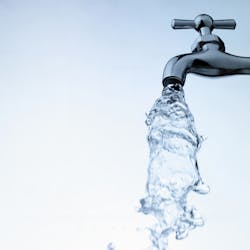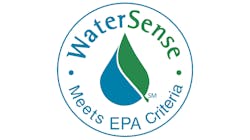WaterSense is slated to be cut from EPA’s proposed 2018 budget
This March the EPA’s Memorandum FY 2018 President’s Budget: Major Policy and Final Resources Decisions was sent to the Acting General Counsel, Acting Assistant Administrators, Inspector General, Chief of Staff and Acting Regional Administrators, outlining final resource levels and policy guidance supporting the EPA’s 2018 President’s budget submission to Congress. EPA’s 2018 budget is submitted at $5.6555 billion — a decrease of 31 percent when compared to the FY 2017 annual continuing resolution level.
The Memorandum, from Acting Chief Financial Officer Dave A. Bloom, notes that the Administration intends to use an evidence-based approach to improve programs and services, including reporting critical performance metrics, and that the Administration’s focus on infrastructure is reflected in funding levels for the nation’s drinking and wastewater infrastructure at $2.3 billion for State Revolving Funds and $20 million for the Water Infrastructure Finance and Innovation Act program.
Focusing on infrastructure is music to most ears, but there are current EPA programs slated to be eliminated. The Memorandum goes on to state, “The agency’s work will center on our core legal requirements, federal-only and national efforts, providing support to states in implementing environmental laws, and easing regulatory burden. In line with this approach, many voluntary programs are eliminated. Locally-focused geographic efforts also are eliminated, including the geographic programs…”
In the President’s Budget: Base Budget Adjustments it is stated, “The WaterSense program is eliminated as part of the effort to better target and prioritize activities to support decision-making related to core environmental statutory requirements … This program reduction supports a refocus on core statutory requirements, avoiding duplication with states or entities, a streamlining of agency priorities, and the reduction of regulatory burden. This reduction also reflects decreased workload due to reduced or eliminated grants administered by the program.”
According to a news release from the Alliance for Water Efficiency, the President’s Budget for FY 2018 lists 50 programs, including Energy Star, at the EPA that should be eliminated. Because the WaterSense program has never been congressionally authorized, it does not have its own budget line item, and for the past 10 years it has been funded only at the discretion of the EPA Administrator.
Industry associations’ thoughts
WaterSense has been around for a little over a decade — the program celebrated its 10th Anniversary June 2016. The WaterSense program officially launched June 12, 2006, in San Antonio, Texas, during the American Water Works Association’s (AWWA) Annual Conference & Exposition.
According to Stephanie Salmon, Potomac Government Relations, on behalf of Plumbing Manufacturers International (PMI), WaterSense is an important program to the industry; plumbing manufacturers have invested millions of dollars in technology research and development as well as production of thousands of innovative, highly engineered WaterSense efficient toilets, urinals, bathroom and commercial faucets, and showerheads.
“We are proud to have developed plumbing products that save water,” said Salmon. “The program has helped develop a nationally recognized and trusted label. Consumers know that any product bearing the label will be more water efficient and perform well. WaterSense is one of the most successful voluntary public-private partnerships in the federal government, serving a vital role of encouraging voluntary reduction of water consumption by consumers and businesses.”
Some of the other important benefits of WaterSense, according to Salmon, include setting performance standards that enable member companies to differentiate their products in the marketplace; the prevention of communities arbitrarily setting flow rates on plumbing products that can adversely impact sanitation and plumbing product performance; and being known as a trusted label for water conserving products.
“WaterSense products have become trusted products — water utilities, many of whom have been facing drought and other supply constraints in recent years, utilize WaterSense certified products as a vital tool that they can promote through conservation outreach and rebate programs, saving ratepayers the expense of each utility certifying water savings of products separately,” explained Salmon. “WaterSense has helped consumers save a cumulative 1.5 trillion gallons of water and more than $32.6 billion in water and energy bills.”
According to Pete DeMarco, executive VP of Advocacy and Research at the IAPMO Group, much like the popular Energy Star program, WaterSense helps consumers easily identify products that will deliver excellent water efficiency results by simply looking for the WaterSense label and the product or product packaging. The WaterSense program requires manufacturers to have products independently tested and certified to be compliant to a vigorous performance specification that not only ensures water savings, but also provides assurance to consumers that the product will perform as well or better than water guzzling models.
“Anytime that a proven, transparent and reputable process can be applied to augment and support manufacturer claims, consumer confidence is improved,” said DeMarco. “The WaterSense label has installed confidence in the marketplace, and as such, just like Energy Star, more and more consumers can know by seeing one label, the WaterSense seal, that they can have greater confidence in their purchase decision.”
CONTRACTOR asked DeMarco what will happen when this program is eliminated — will consumers on their own take action to conserve water.
“That’s highly doubtful, especially in areas where water scarcity isn’t always a top of mind concern,” said DeMarco. “The reasons for this are numerous, but perhaps the biggest reason is that water remains to be a highly-undervalued resource in most areas of the country. That’s what makes WaterSense so important. It allows consumers to easily make purchasing decisions that will deliver water savings and excellent performance without going ‘out of their way’ to research those concerns.
“Another important matter to consider is that many water utilities and districts use the WaterSense specifications as the basis for their rebate incentive programs,” continued DeMarco. “If WaterSense funding is cut, utilities and other entities will then create a patchwork of varying water-use levels and performance specifications, differing location by location. This would create confusion for the consumer as well as creating an enormous burden to manufacturers attempting to meet numerous and often contradicting specifications and marking requirements.”
According to DeMarco, the elimination of the WaterSense program would be nothing short of tragic.
“Our focus now is to do everything possible to work with all industry stakeholders; manufacturers, plumbing engineers, contractors, other codes and standards developing organizations and consumer groups to address this matter clearly and eloquently with the new EPA leadership, Congress and the Executive Offices and explain the necessity to continue to fund this extraordinarily cost effective program,” said DeMarco.
In May the Plumbing Industry Leadership Coalition (PILC) is meeting in Washington to consider additional industry-based policy measures to advocate for the continued funding of WaterSense.
“The Water Sense program is important on many levels — increasing awareness of the need for water conservation and the products available to meet that need would be first and foremost,” said Plumbing Heating Cooling Contractors — National Association Vice President of Regulatory Affairs Chuck White. “Beyond that, though, establishing criteria for reducing consumption and testing products to meet that criteria is a key component. Products may be produced with unproven claims of huge savings, or they may result in water savings, but sacrifice system performance. Utilizing the WaterSense label provides consumers with assurance of product reliability.
“Our goal at PHCC is to position our members as ‘contractors of choice’ in their respective communities, as well as to ensure that all those within our industry are protecting public health and safety and the environment,” continued White. “That’s why it’s a win-win for PHCC to support WaterSense.”
Contractors’ thoughts
CONTRACTOR interviewed plumbing contractors located in different parts of the country about the WaterSense program.
At Milestone Plumbing Inc., located in Wauwatosa, Wisconsin, Jessie Cannizzaro, Master Plumber, has installed quite a few different fixtures including showerheads, faucets and toilets with the WaterSense label.
According to Cannizzaro, her customers are somewhat familiar with the label and what it means, but many consumers are more generically familiar with the concept and not as familiar with the label recognition. Customers do seem to want to conserve water.
“I think the [WaterSense] program has been beneficial for consumers and our industry in that it has helped to educate and bring awareness to water conservation efforts,” said Cannizzaro. “While some products may not be a perfect fit for everyone, the program has started conversations and made people think about their water usage and ways to cut back on waste.”
Eric Aune of Aune Plumbing LLC, based in Sherburne County, Minnesota, has installed many labeled products, most of them toilets. He rarely gets requests for faucets or toilets specifically labeled under the WaterSense program.
“I think everyone wants to save water, but most will pursue products that perform at high levels in comparison to all others regardless of any program labeling,” said Aune. “The majority of plumbing products are already engineered to meet water saving requirements, which takes most of the concern away for many clients. I think most people just assume a new faucet is going to use less water for normal operation today versus a 10- or 20-year-old faucet.
“I think fixtures that use less water overall is a step in the right direction of course, but mandating through code requirements has already gone a long way to getting water saving products into the marketplace,” said Aune. “I feel that if the program does go away individual manufacturers will continue to produce the same water saving products and make efforts to market those products as such. Consumers ultimately will buy on performance, recommendations by their plumber and availability locally. I do not feel the absence or presence of the program will make a significant difference.”
According to Norman Sanders, service manager at Marlin Services in Phoenix, plumbers have installed several products with the WaterSense label, but less than half of the company’s customers bring up WaterSense.
“We have very few customers that bring up water conservation — most of our customers are more concerned about style and appearance,” said Sanders. “Living in the desert you would think that most customers would be more concerned with water conservation, however that is not the case. Most customers are willing to put in desert landscaping and feel that is enough to conserve water.
“I will say however that manufacturers have improved the WaterSense products and they are more effective than they used to be,” continued Sanders. “Some of the 1.28-GPF toilets work very well and there are some of the showerheads that work better than others. Since most manufacturers are set up to meet these guidelines, I don’t think they will go backwards.”
CONTRACTOR’s columnist Dave Yates, owner of F.W. Behler, York, Pennsylvania, is a believer in the WaterSense program.
“I'm a big fan of WaterSense — all of our toilets (two here at the office and shop; four at our home, and two in our rental home in Chincoteague are 1.28-HETs) are WaterSense,” said Yates. “Given my own personal experiences — we haven't experienced a single clog with the four eight-year-old WaterSense 1.28-GPF water closets in our home, and waste travels almost 200 feet from toilet to street, so all the hoopla over drain-line carry is bunk in my opinion.”
Read Yate’s column about Drain-line Carry. Also, read Yates’ column about Drain-line carry and HETs.
With regard to consumers being aware of water saving products, Yates believes the contractor bears the responsibility of educating their customers.
“Primary responsibility rests on me to promote WaterSense and educate our customers to the benefits, which includes not just water conservation, but municipal sewer charges if based upon gallons of water used, the energy cost reduction potential for heating less potable hot water, and extended lifespan of the water heating appliance,” explained Yates. “The first primary concern, expressed to me, is about the performance and that's why having the WaterSense approval is vitally important. The product must perform as well, or better, to attain the WaterSense label.
“Personally, if WaterSense is eliminated by the EPA due to a reduced budget from our Federal Government that would be a sad day for those of us who believe in promoting the conservation of one of the most precious natural resources we have at our collective disposal,” said Yates.
CONTRACTOR will continue to cover the elimination of the WaterSense program. Do you have an opinion on the WaterSense program? If so, please e-mail Candace Roulo at [email protected].
About the Author
Candace Roulo
Candace Roulo, senior editor of CONTRACTOR and graduate of Michigan State University’s College of Communication Arts & Sciences, has 15 years of industry experience in the media and construction industries. She covers a variety of mechanical contracting topics, from sustainable construction practices and policy issues affecting contractors to continuing education for industry professionals and the best business practices that contractors can implement to run successful businesses.


